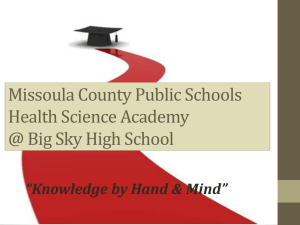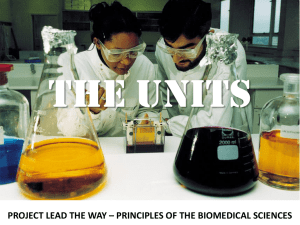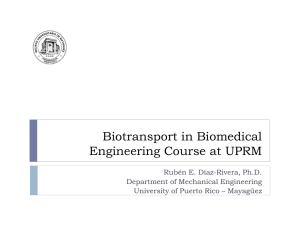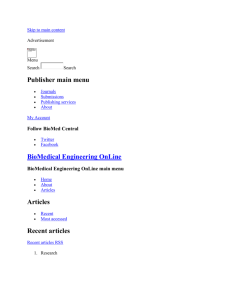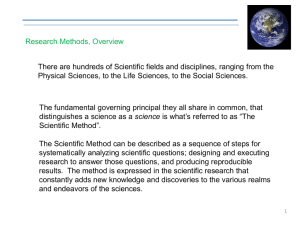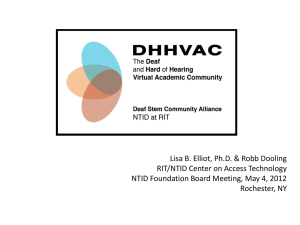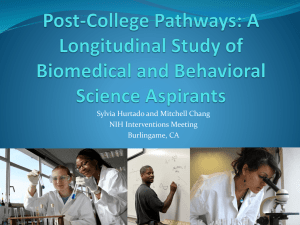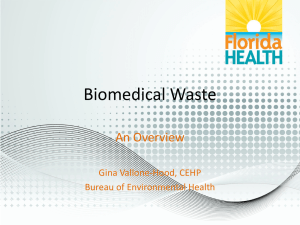Sylvia Hurtado, UCLA - Vision and Change in Undergraduate
advertisement
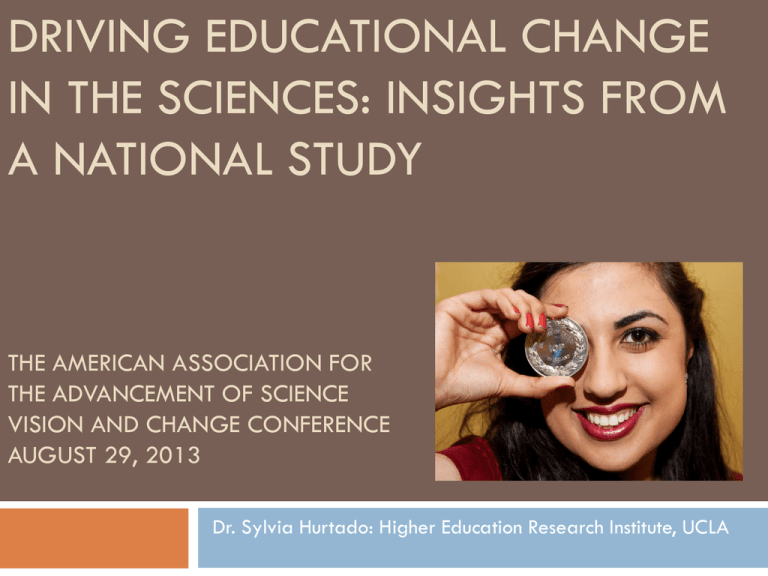
DRIVING EDUCATIONAL CHANGE IN THE SCIENCES: INSIGHTS FROM A NATIONAL STUDY THE AMERICAN ASSOCIATION FOR THE ADVANCEMENT OF SCIENCE VISION AND CHANGE CONFERENCE AUGUST 29, 2013 Dr. Sylvia Hurtado: Higher Education Research Institute, UCLA Broad Overview of Study Following entering cohort of students in 2004 Baseline sample: 63,000 aspiring STEM majors across 350 institutions Multiple surveys 2004 Freshman Survey 2005 Your First College Year Survey 2008 College Senior Survey 2011 Post-Baccalaureate Survey Merged with IPEDS, National Student Clearinghouse, Registrar, MCAT, College Board, and Faculty Survey data Qualitative data collection Introductory STEM classroom mixed methods study Focus groups with STEM graduate students Trends in Student Interest in the Biological Sciences Reported at the Beginning of Their Freshman Year 14.0% 12.0% 10.0% 8.0% 6.0% 4.0% 2.0% 0.0% 1971 1976 1981 1986 1991 1996 2001 2006 2011 URM White/Asian Total Predicting Completion for Biomedical Science Aspirants Data from several sources: Freshman Survey, IPEDS, National Student Clearinghouse, Faculty Survey, Best Practices in STEM survey Biomedical sciences completion 34.1% of biomedical science aspirants earned a biomedical science degree within six years; 31.8% of biomedical science aspirants earned a bachelor’s degree in another field within six years 34.1% of biomedical science aspirants had not completed a bachelor’s degree within six years Among Biomedical Science Aspirants Who Completed in Another Field, Where Did They Complete? Other STEM 7.4 3.8 Other Social Science 19.6 Psychology 10.9 Business 17.1 12.8 Arts & Humanities Other Field 13.3 15.2 Professional (e.g., architect, law) Education Predictors of Biomedical Science Completion Attending an Emerging Hispanic-Serving Institution (+) Attending a larger campus (-) Prior preparation HS GPA (+); enhanced on campuses where faculty more often incorporated student-centered teaching practices Years of study in HS math/science; SAT composite Pre-college community service in a hospital (+) MD aspiration (+) Mitigated at more competitive campuses (selectivity; curved grading) Faculty Including Undergraduates in Research Percentage of Faculty Engaging Undergraduates on a Faculty Research Project 90.0 80.0 70.0 60.0 50.0 40.0 30.0 20.0 10.0 0.0 Biology Faculty Other STEM Faculty Differences significant at p<0.001 Non-STEM Faculty Faculty’s Use of Student-Centered Teaching Student-Centered Pedagogy 52 50 48 46 44 42 40 Biology Faculty Other STEM Faculty Differences significant at p<0.001 Non-STEM Faculty Student-Centered Practices in Introductory Science Courses Study of 15 campuses, 90 classrooms Greater proportion of course time devoted to lecture corresponded with reduced academic engagement among students More time devoted to class discussion or group work significantly correlated with significantly higher levels of engagement Creating an inclusive classroom where students felt comfortable asking questions corresponded with increased levels of academic engagement Introductory Science Courses In a lot of my biology courses, the professor just sort of talks at me, and I’m like – I don’t feel, like, as engaged or I feel like, in those courses there is a lot more memorization only, which is why I don’t get as much out of them because I’m very hands-on. Like, if I’m doing something in the class, I can grasp that I’m understanding it, but if the professor is just talking at me, writing stuff on the board, expecting me to write it down, like that’s doing nothing, and then I’m completely disengaged in class. (Southeastern Private Master’s College) Assessing Change National instrument: HERI Faculty Survey Local baseline data National baseline data Student interest – CIRP Freshman Survey Classroom-based surveys Pre- and post-test of students Survey of faculty pedagogical strategies Creating Partnerships Make friends with you Institutional Research Directors Connect with your alumni offices Connect with faculty across departments and programs who are innovating Get Some Data, then Expand Start small and collect the data Leverage a small study to begin changing hearts and minds within the department Contact Info Faculty/Co-PIs: Sylvia Hurtado Mitchell Chang Kevin Eagan Graduate Research Assistants: Tanya Figueroa Bryce Hughes Administrative Staff: Dominique Harrison Papers and reports are available for download from project website: http://heri.ucla.edu/nih Project e-mail: herinih@ucla.edu This study was made possible by the support of the National Institute of General Medical Sciences, NIH Grant Numbers 1 R01 GMO71968-01 and R01 GMO71968-05, the National Science Foundation, NSF Grant Number 0757076, and the American Recovery and Reinvestment Act of 2009 through the National Institute of General Medical Sciences, NIH Grant 1RC1GM090776-01. This independent research and the views expressed here do not indicate endorsement by the sponsors.
